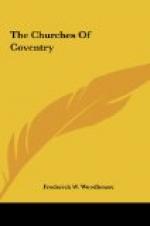The third, traditionally called Wade’s tomb, probably belongs to John Wayd, a Mercer, who lived in Coventry in 1557, but no inscription remains.
There are seven shields of arms on the side, nearly all defaced, a motto “Ryen saunce travayle,” and nine images in low relief which present quaint studies of early sixteenth-century costume.
The matrices of brasses are still visible in several parts of the church. Sir James Harrington, writing in the reign of James I, tells a curious story of their loss:
The pavement of Coventry church is almost all tombstones, and some very ancient, but there came in a zealous fellow with a counterfeit commission, that for avoiding superstition, hath not left one pennyworth nor penny breadth of brass upon all the tombs, of all the inscriptions, which had been many and costly.
The last monument that need be mentioned is upon the wall over “Wade’s tomb.” Twenty-six verses of eulogy follow these opening lines:
An Elegicall epitaph, made upon the death of that mirror of women Ann Newdigate; Lady Skeffington, wife of that true moaneing turtle Sir Richard Skeffington, Kt., and consecrated lo her eternal memorie by the unfeigned lover of her vertues, Willm. Buistrode, Knight. (She died in 1637, aged 29).
The present organ was built by Henry Willis and erected in 1887. It is a four-manual and pedal instrument and has fifty-three stops.
The old organ on which Handel played more than once, stood on a raised platform at the west end. It was the work of Thomas Swarbrick of Warwick, a German by birth, in 1733. He also built those of Trinity Church, St. Mary, Warwick, Lichfield, St. Saviour Southwark, Stratford-on-Avon, and Amsterdam.
The best of the ancient glass now remaining has been collected into two windows, one on either side of the apse. Much was brought from the clearstory where six windows on the south and all save one on the north side still have panels made up of a mosaic of fragments with portions here and there of which the subject is intelligible. From what remains in the tracery we may gather that there was a row of eight angel figures filling the spaces immediately over the lights. Some of these or similar ones, are now in the apse. They are represented as covered with feathers and standing on wheels and each holds a scroll over the head with inscriptions in very contracted Latin. A few less fragmentary pieces may be found, e.g., in the north window, Judas giving the traitor’s kiss, in the north clearstory the arms of Trenton and Stafford, mentioned and figured by Dugdale, in the south, the figure of a man in a red gown kneeling with a scroll inscribed “deo gracias” and over his head “groc(er) de london”—doubtless a donor. Of modern glass there is a great amount but little worth mentioning savs on account of the persons commemorated. One window in the Lady Chapel is a memorial of the Prince Consort and one in the Mercers’ Chapel is of interest as a deserved memorial to Thomas Sharp the Antiquary to whose labours all later historians of the city are so deeply indebted. He died in 1841.




